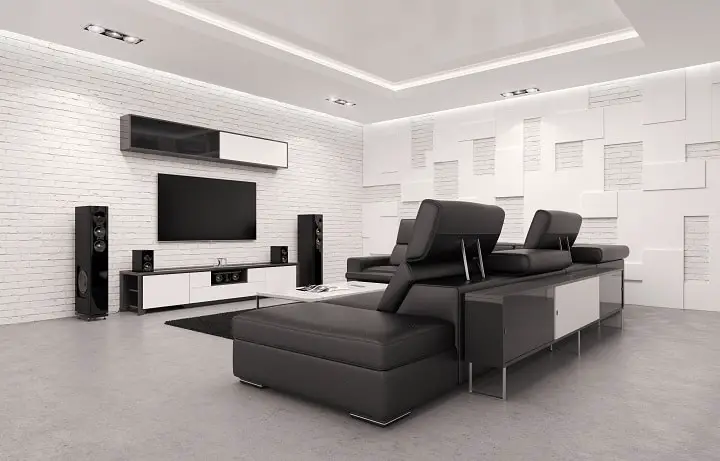Contenuti
Intro
So you are buying a new TV and have narrowed your choices down to two models: Crystal UHD and QLED. Which one is the best? Today we will compare Crystal UHD with QLED and explain which one is better in the long run.
Choosing the right TV can be difficult because there are so many features, panel types, marketing terms, technologies, and specifications to consider. Not to mention the budget.
Understanding the differences between Crystal UHD and QLED can save you from making a costly mistake. These two terms are designed by Samsung and are found on most Samsung TVs; other TV manufacturers have their own marketing terms for similar features and technologies. For example, if you want to know how to choose between Oled or Qled you will find all the information on our Page.
What is Crystal UHD, How It Works & What It Means
Crystal UHD stands for Ultra-High Definition, also referred to as “Ultra HD” or simply “UHD.” In other words, Crystal UHD TVs are standard LCD displays but at 4K or higher resolutions. This means that the screen has 3840×2160 pixels. Crystal UHD is more a description of resolution capabilities than a feature. Basically, it means that the TV is compatible with 4K.
Samsung often markets its Crystal UHD TVs as having a 4K “Crystal” image processor that beautifully upscales all media to 4K. Most Crystal UHDs do not have such a processor, with the exception of the TU8000 series, but most smart TVs already have processors that can upscale media to 4K. In other words, you should not worry about whether or not your TV has a 4K-Crystal processor because it does not make much difference.
Details about Crystal UHD
To clarify, the term Crystal UHD is a TV that is capable of Ultra High Definition and may or may not use a 4K-Crystal processor to upscale media to 4K. You can think of Crystal UHD TVs as improved LCD TVs with support for higher resolutions. It is the same as HD (720P) or FHD (1080P).
Remember, Crystal UHD is not a panel technology. Crystal UHD TVs use LCD technology with LED backlighting. In my opinion, you should not worry too much about the whole “Crystal UHD” gimmick and focus on more important features.
Don’t get the wrong idea. UHD TVs are not bad at all. Almost any display that supports 4K will look good. The problem is that UHD is not a special feature, panel or technology, it simply means that the TV is 4K compatible. On that note, UHD TVs are also cheaper.
What is Qled, How It Works & What It Means
QLED is different because it is a type of panel. QLED stands for Quantum-Dot Light-Emitting Diode, essentially a display that uses Quantum dot technology. The exact technology is very complicated; a simple way to visualize the technology is that Quantum Dot technology adds an additional color filter to the display that increases brightness and contrast levels.
Normally, a TV uses an LED for backlighting and shining on the LCD panel that creates colors. QLED TVs are based on the same design, the quantum dot filter is added between the LCD panel and the LED backlight.
The filter also improves the color gamut, although it is not very noticeable in everyday use. As for image quality, the QLED offers great images with very vivid colors, especially at 4K.

Advantages of Qled vs Crystal UHD
QLED TVs offer the best brightness performance making them an ideal choice for watching during the day or in a bright room. They also offer better viewing angles, which means the image quality does not change regardless of your sitting position. They are also more energy efficient and do not suffer from burn-in so it increases the life of the TV.
Controlling the light entering each pixel allows us to adjust saturation and brightness. The intensity is greater. This high level of brightness is especially noticeable when watching television in broad daylight.
This means QLED TVs are a step above Crystal UHD models, better contrasts, colors & lighting levels thanks to Quantum Dots technology.
Panel Resolution
Samsung Crystal UHDs feature Ultra Hi-Definition (UHD) technology, which offers (typically) 4K viewing. The number of pixels varies with screen size, providing more or less clarity.
Meanwhile, QLED TVs offer more accurate colors and some even play 8K content. They are able to activate each pixel separately, achieving perfect color reproduction.
Price Difference Crystal UHD vs Qled
Samsung Crystal UHDs are significantly less expensive, while Samsung QLEDs have more advanced features and therefore cost much more.
It all depends on the quality of the image you need, so always keep your priorities in mind. The goal of this article is to provide you with useful information so that you can select the model best suited to your needs.
Crystal UHD or Qled for Gaming?
Samsung’s QLEDs are the best choice if you are an avid gamer. Many of them include Game Enhancer+ and FreeSync technology, as well as improved image and sound quality. Samsung’s Crystal UHD, on the other hand, includes less up-to-date versions of Game Enhancer, but still provides smooth gaming.
Audio Differences
Both Crystal UHD and QLED models use Q series speakers and sound bars to produce surround sound using Q Symphony technology.
Both models have Adaptive Sound technology. The sound is optimized and takes into consideration the environment in which you are watching television and adjusts the audio to fit and provide the best possible sound quality.
QLED TVs, on the other hand, include Adaptive Sound+, an upgrade to Adaptive Sound technology that improves sound quality by adapting it to the room and installation locations for optimal sound quality no matter where you are watching.

